The Ministry of Pensions during and after the Great War
- Home
- World War I Articles
- The Ministry of Pensions during and after the Great War
The Ministry of Pensions was a truly monolithic organisation, by the end of 1920 it had 19,121 staff, was paying 1,600,000 pensions, and spending more than £23,000,000 per year.
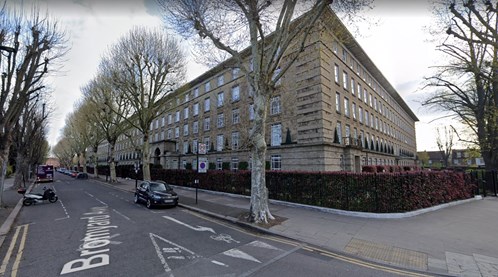
Above: The Bromyard Avenue site in Acton that was the Ministry of Pensions offices (built in about 1921) seems now to be a residential complex.
What is often lost in this scale however are the finer details of how the Ministry of Pensions calculated and paid these pensions and it is this that we will look at in this article.

At the outbreak of war in 1914, the pension system was relatively small scale: the War Office and Chelsea Hospital dealt with Army Pensions whilst the Admiralty and Greenwich Hospital dealing with Naval Pensions. Various other allowances were dealt with via Paymasters.
Each of these departments stepped up in August 1914 and began to deal with the increasing numbers of claims being for disability pensions however the major work began with the payment of Widows pensions from early 1915[i]. Unfortunately, most of the early details regarding the payment of pensions have been lost to time, the exact process not being known. We do know however that the system was creaking at the seams and delays in payment soon crept in. To take some of the load away the Pension Issue Office[ii] was established to take over the administration of the actual pension payments and any queries regarding these. It was not long before this system was again struggling to keep up.
By late 1916 it was apparent that, for all the work that had been put in, the current pension system was failing badly and so the decision was made to form the Ministry of Pensions to take over the work of pension administration. The Ministry of Pensions formally took over control on 15 February 1917 and by August 1917 it consisted of 5 divisions –
Division 1 – Awards (Officers, Dependants & Widows branches)
Division 2 – Awards (Soldiers, Sailors & Alternative Pensions branches)
Division 3 – Medical Aftercare
Division 4 – Discretionary Grants
Division 5 – Finance (including the Pension Issue Office).
These divisions were to remain in place and form the backbone of the Ministry for the remainder of the war and the years directly afterwards. During 1918/19 a temporary branch was created to deal with class Z demobilisations however this work was quickly dealt with and the branch disbanded.
Between 1920 and 1926 much of the work of Division 2 was decentralised and the work passed out to a series of regional offices, the work having declined sufficiently by 1926 that it was re-centralised at Acton. During the same period, the work of the Pension Issue Office was also temporarily decentralised, with an office in Pilton, Edinburgh, for cases falling under the Scottish region.
It is into the above system that we have to fit the records held by The Western Front Association.
The Western Front records
The Western Front Association holds the following record sets
1) Naval - Pension ledgers
2) Mercantile marine - cards
3) Pension Ledgers (both for pensions for survivors and those of deceased soldiers)
4) Other ranks died – cards
5) Officers and officers widows - cards
6) Widows and Dependants of other ranks cards died – cards
7) Other ranks survived - cards
Although the exact background of some of these records has previously been unclear it has become apparent, through a close reading of the 1919 and 1920 Select Committee reports on the Ministry of Pensions, that these can now be traced back to their origins in the various awarding branches and it can be determined how they fitted in to the overall process.
The administrative process of calculating a pension
An initial claim for a disablement pension was started in one of two main ways – the record office notifying the Division that a man was discharged or a medical board notifying the Division[iii]. In the case of widows, a claims form was initiated primarily by the War Office although the widow could contact them to claim. For alternative pensions, the information was collected by a local committee and forwarded on.
For the purposes of a claim for a disabled man, the details of the pension claim were passed through to the relevant Division and the work of calculating the pension could begin. As far as can be ascertained the general process was that the Central Registry of the branch opened an initial pension file[iv] and created two pension cards along with a ‘large pension card’[v].
The two pensions cards were created to manage the pension claim and consisted of one card that was used to create an alphabetical ‘finders’ card index in the name of the claimant. This card was initially created as a placeholder to ensure all of the necessary paperwork was received[vi] before it was filed away as an index card.
The second, ‘regimental’, card was used to record the details of the soldier and his regimental details. At this date, the sections within the Awards branch worked on a regimental basis so there originally existed multiple independent ‘runs’ of ‘regimental’ cards.
The ‘‘large pension card’ was passed through to the relevant Awards section who would calculate the pension award and record details on an Award Sheet [see below].
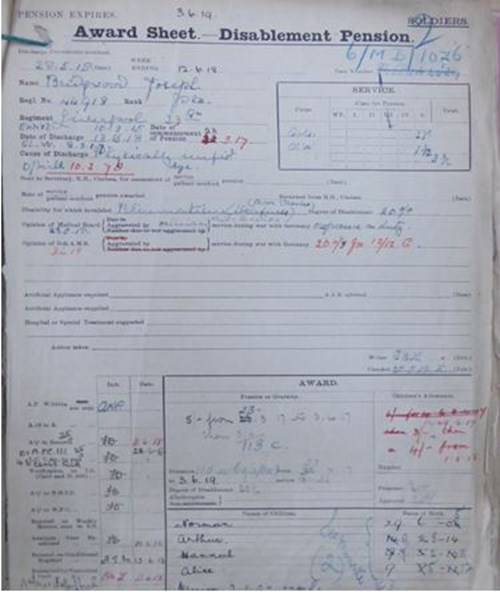
Above: Pension Award Sheet for a disablement pension
It is unclear what exactly this ‘large pension’ card was however it may be the mystery card in the image below [vii].
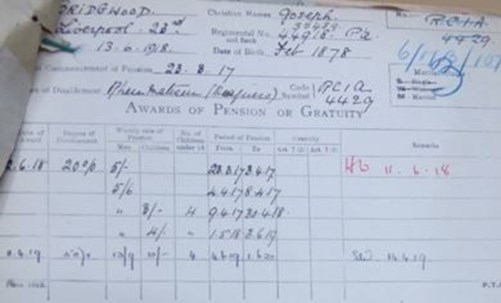
Above: Unknown card from PIN26 record
Details of the pension award that was to be paid would be then forwarded to the Pension Issue Office who would take over the management of payments and any queries related to these.
Where a case was a conditional award and not a final award, a temporary pension could be paid. The case would be placed on a ‘conditional list’ and held until the end of the existing award so that the pension award could be reviewed accordingly.
Although there are differences in the exact processes, many lost to time, the above process reflects the general route by which pensions were calculated under the Ministry of Pensions.
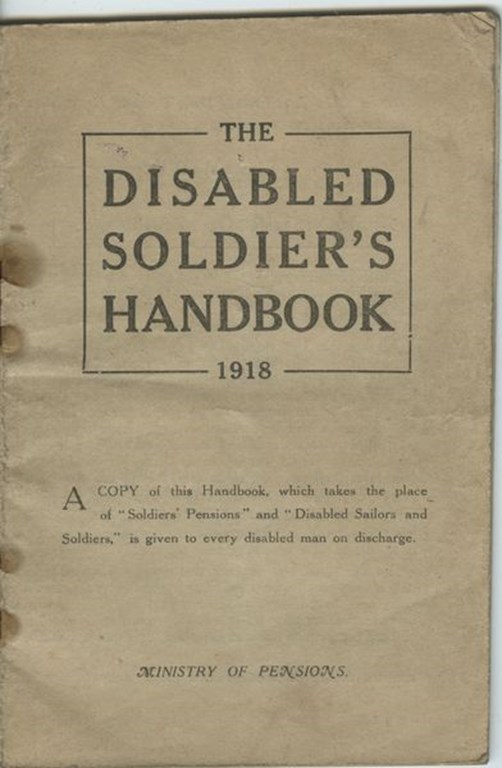
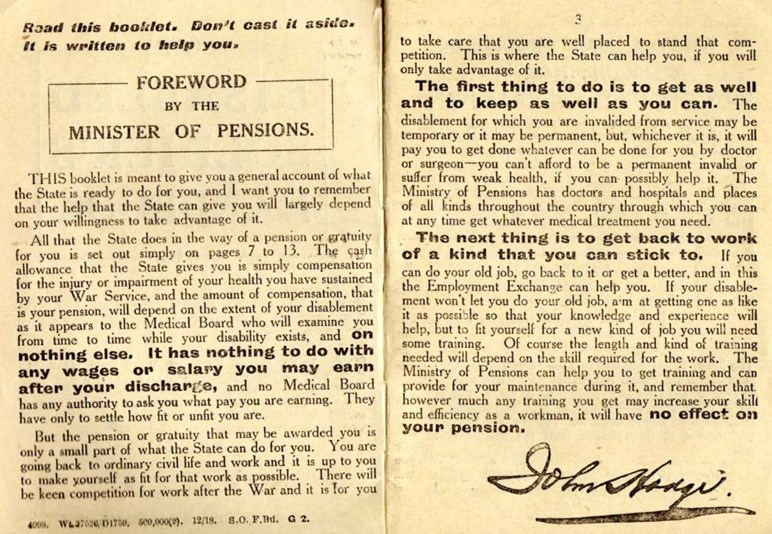
Above: A handbook was given to disabled soldiers after the war. It is likely this was intended to help in navigating the pension claim system.
The ‘Finders’ and ‘Regimental’ cards
An example of the ‘finders card’ index can be seen in that which survives from the dependant’s branch, the ‘Widows and Dependents of Other Ranks Died’.
The ‘finders card’ [below] shows personal details of the claimant, Mrs Sarah Beckett and the soldier she was claiming a pension against.
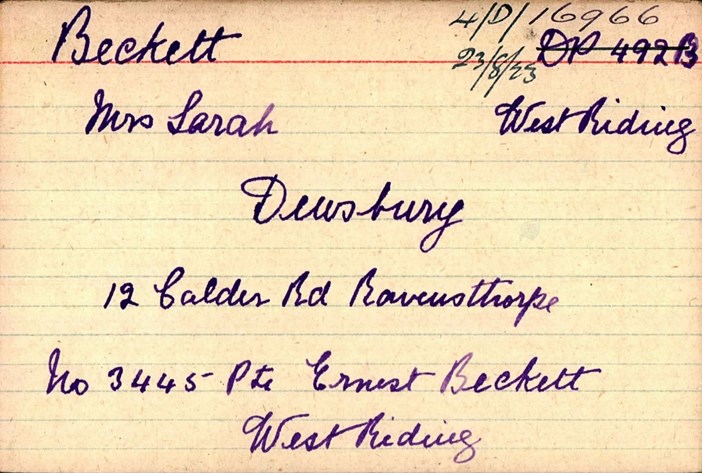
Above: A 'Finders card'
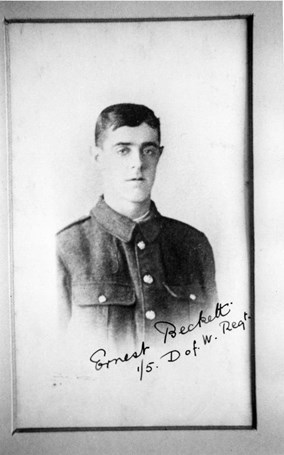
Above: Ernest Beckett whose pension cards are highlighted here
The details on the ‘finders card’ would allow the associated ‘regimental card’ to then be located in the second card index.
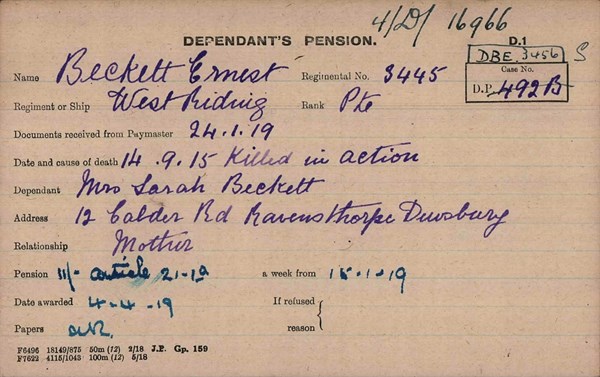
A 'Regimental card'
The name of the claimant shown on the ‘regimental card’ could likewise be used to locate the ‘finders card’ if details on it needed to be checked for any reason.
Looking at cards for widows from the same ‘Widows and Dependents of Other Ranks Died’ set shows us the ‘finders card’ for Emily Allen and the ‘regimental card’ for the associated soldier, Benjamin Allen [see two images below].
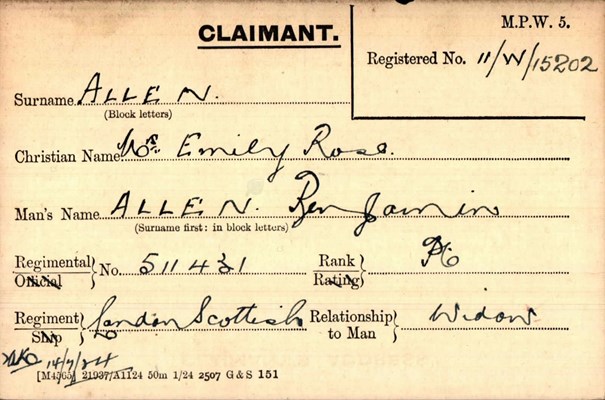
A 'Finders card'
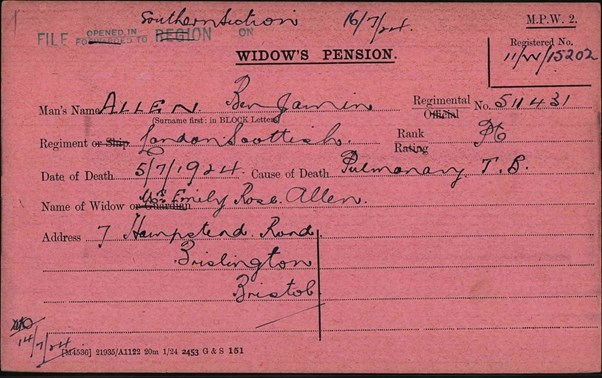
A 'Regimental card'
This demonstrates that the system used in the dependant’s branch mirrored that used in the widow’s branch. It is also clear from the 1919 and 1920 Select Committee reports on the Ministry of Pensions that the same system was used in the recording of pension claims for disabled soldiers.
It is known that these card indexes were in use from at least early 1915 and continued in use until the 1980s
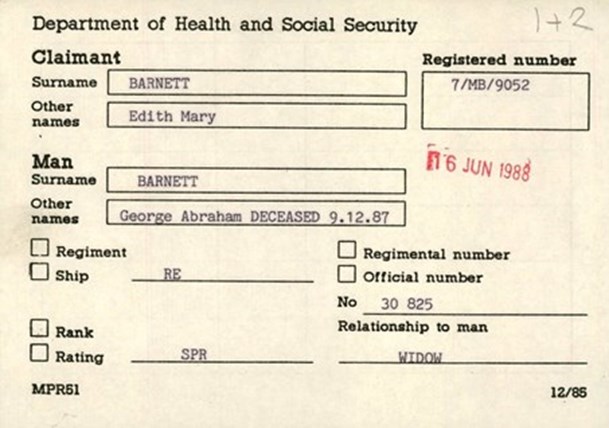
Above: a card created by the DHSS in the 1980's
Decentralisation and Centralisation of the Ministry
In 1919/1920 the Ministry of Pensions decentralised the award of pensions for Division 1 and 2 work, with the exception of Widows and Officers, to one of the 11 new regions spread across the United Kingdom. At this point, the Pension Issue Office work was retained in London alongside the Headquarters functions of the decentralised divisions[viii].
The decentralised regions would only deal with existing claims for disabled men, new claims still being made centrally before being distributed out to the regions[ix]. The central Divisions in London appear to have retained and maintained the card indexes that had previously been established. The Regional Awards Officers would, however, request and retain any pension case files which were in existence for a particular man – these files would be passed from one region to another as required – and the regional offices would make any changes to the pension, notifying the HQ branch and Pension Issue Office as necessary.
The awards sections for all of the pension divisions, even those not decentralised, swapped over to being internally organised using the regional system from 1919 onwards. Examination of the ‘finders’ and ‘regimental’ cards shows the new regional numbering system that was noted on them. The Pension Issue Office continued to work on a regimental basis until 1922/23 before changing over.
As time went on and work-load decreased the decentralised system was found to cause such problems, each of the regions having their own way of working, that the duplication of work was deemed to be inefficient. By July 1926 all of the work for the regions had been re-centralised at Acton in London. The Pension Issue Office moved to their new offices at Acton in 1921 and, in July 1926, was finally re-joined by the Pension Issue Office work that had been undertaken at Pilton, Edinburgh, since November 1921.
The Pension Ledgers
In addition to the WFA pension cards, the second major part of the Western Front Association record are the pension ledgers, form SB36. These are perhaps the surviving records most intimately connected with the decentralisation and centralisation of the Ministry of Pensions yet are the most mysterious as they have been heavily weeded and the surviving contemporary material makes little reference to them.
The ledgers were used across the majority of the award branches, with some minor differences. The front of these ledgers show details of pension claimants and, in some cases, the rear of the card shows details of pension calculations made post-1919. The purpose of the ledgers appears to be to give the clerks dealing with claims a ready summary of details without needing to trawl through the pension case file.
To take a deeper look at the working of the ledgers, we will start by looking at those ledgers maintained centrally and then consider the ledgers used within the decentralised branches of the Ministry of Pensions. (The known addresses of the decentralised branches is detailed in the appendix below)
It would appear that the widow's branch of the Ministry of Pensions was always centrally maintained, it was never itself decentralised although they did re-organise from a regimental to a regional system in 1922[x]. This change can be seen in Widows cards where the regional system reference has been added to an existing ‘regimental’ card that was created following a death in March 1920 [see below].
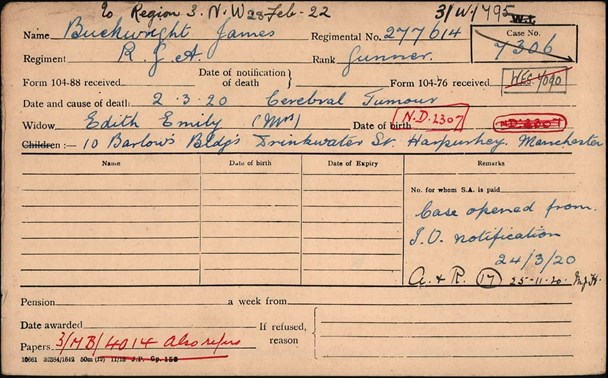
A similar update was made to the related ‘finders’ card.
In this case, the man’s death was notified to the Pension Issue Office, due to an existing disability pension claim, and they, in turn, notified the Widows branch who created the new widow’s claim.
The notation on the card shows ‘To region 3 NW 28 Feb 1922’, which appears to tie in with the creation of the matching ledger – the first dated comment on which is 23 February 1922 – and is indicative of the branches internal re-organisation.
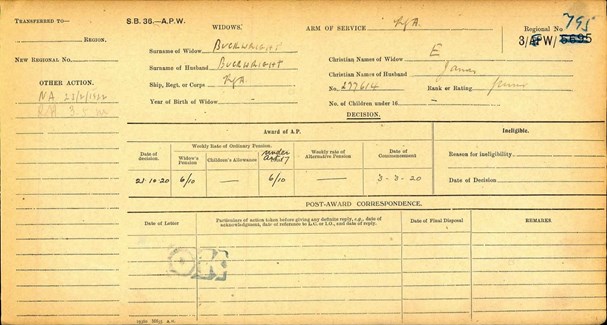
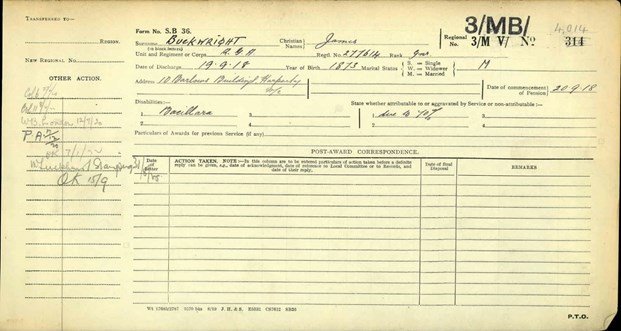
The ledger was only created when needed under the regional system.
Analysis of the surviving ledgers, forms and hand-writing indicate that those ledgers from the decentralised regions were created only when the branch was first notified that a claim had been received in to their area. If a claim ceased to be made in a particular region then the case files were transferred to the new region and, in most cases, it appears that the ledgers were retained so that they could be re-opened at a later date should it be necessary.
The earliest award details shown are from the first award calculations made after the formation of the relevant decentralised pension region. This means that, if a case was never dealt with by a decentralised region during the period of decentralisation there would not be a ledger created for that case. Some cases for decentralised regions were dealt with in London however these, if ledgers were created, appear not to have survived.
Evidence from the few additional forms found filed amongst the surviving ledgers shows that queries for regions which had been recentralised were being sent to the relevant awards section in London, the ledgers then being updated accordingly. This indicates that, at the very least, post centralisation, the ledgers were being held in London and used by the relevant award section covering that region.
Over time, however, the ledgers went out of use and they appear to have moved to being used more as another form of index card rather than any real record of note within the Ministry of Pensions.
The above is an interpretation of the process that has been deduced from the records saved by The Western Front Association, but if there are any former employees of the Ministry of Pension, or its subsequent reincarnations (such as the DHSS) that can add detail to the above article, please do get in contact. Please see the article Did you work at the Ministry of Pensions? for more information and how to get in touch.
Article by Craig Suddick
Notes
[i] Separation Allowance was paid for the first 26 weeks of any death so the first Widows Pensions were not paid until
[ii] This office would be the largest in the Ministry of Pension. Staffing increased from 570 in August 1916 to a peak of 5,934 in 1920/21.
[iii] For an Alternative Pension claim the applications were originally compiled in full by the Local Committee but from April 1920 onwards the Local Committee simply passed the claim form to the relevant region for processing.
[iv] The claims were each assigned an individual reference number (shown on the top right of the card). This reference number varied depending on when the claim was made, and the type of claim’ and could change over time – most notably following the introduction of the regional system.
[v] The card is from a PIN26 record, no surviving copies are believed to exist within the Western Front Association records. Full details of the ‘large pension card’ are not known however it is not the surviving pension ledgers are these post-date the reference to the card, being only created following decentralisation. A 1919 committee report describes this as ”Another large card is also prepared, known as the Record card, which contains a provision for record of all pension award is made to the man, and this is mainly for statistical purposes. The documents and the Record card are sent together to the appropriate group and the work of the registry in connection with a new case”
[vi] The Special Temporary Allowance Section was responsible for chasing any missing details and ensuring that the Pension Issue Office were advised to continue temporary payments whilst the pension was being calculated.
[vii] At this point fuller details of the ‘large pension card’ remain unknown however it appears it was meant as a record card to record the awards that had been made. It is known that it is not the same the as the pension ledger. The card shown here was discovered in a PIN26 file and may be the only surviving example of its type.
[viii] By 1921 the Pension Issue Office dealt with temporary pensions, disablement pensions, service pensions from 18 September 1914, widows and dependant pensions from 18 September 1914, gratuities for widows, gallantry pensions in addition to issue regarding treatment and training allowance for sick and disabled men. The office was also responsible for any payments due to the estate of any deceased pensioner.
[ix] ‘Headquarters’ in London also continued to deal with all awards for Foreign/Colonial, pre-war, service with disability pensions and 'difficult cases'.
[x] Plans to decentralise the branch were discussed but at present there is no evidence that this was undertaken.
Appendix
Known addresses of decentralised offices
Region 1 "Scotland" : Edinburgh
Region 2 "Northern" : 14 Clayton Street, Newcastle
Region 3 "North West" : Moseley Hotel, Manchester
Region 4 "Yorkshire" : 7 Boar Lane, Leeds
Region 5 "Wales" : Old Technical School, Dumfries place, Cardiff
Region 6 "West Midland" : Birmingham
Region 7 "East Midlands" : Lionel Street, Nottingham
Region 8 "South West" : Clifton Down Hotel, Bristol
Region 9 "Eastern" : part of London, Region 10 (announced July 1920 that it would be merged)
Region 10 "London" (or "Metropolitan") : Awards based at various sites in central London
Region 11 "South East" : part of London, Region 10 (announced July 1920 that it would be merged)
Region 12 "Ulster" - not known
Region 13 "Southern Ireland" - Dunlop House, Abbey Road, Dublin
Oddly, even though the MoP didn't use 13 regions for pensions, they still used all 13 regions for the purposes of medical assessment boards.





